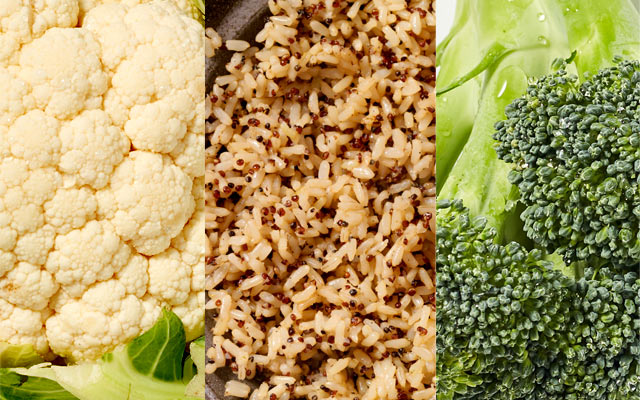Low-carb diets have become popular in recent years — and if you’ve tried one (or wanted to try one), there’s no shortage of places to turn to for advice. Whether on health blogs, in books, or in magazine articles, recommendations abound on “good” and “bad” carbs, how many carbs to eat, and whether or not to eat carbs at all.
Indeed, paying attention to the type and amount of carbohydrates you consume can have health benefits. Low-carb protocols such as the ketogenic diet have caught on, in part, because research shows they may help improve blood-sugar balance, support optimal hormone function, protect against cardiovascular disease and cognitive dysfunction, guard against other chronic conditions like type 2 diabetes and cancer, and support healthy weight loss.
But one of the most useful ways to think about carbohydrates is one of the least talked about: how your body responds to them. Most articles give one-size-fits-all recommendations for carb consumption, but the body’s response to these nutrients is highly individualized, based on genetics, microbiome, adrenal health, and more.
Your unique genetics and unique microbiome are the biggest factors in how you convert food to fuel and keep blood sugar and insulin steady.”
“There’s a lot of genetic variation in how much certain carbohydrates raise insulin,” says functional-medicine and integrative practitioner Jill Carnahan, MD, ABIHM. The triggering of excess insulin can be one of the negative consequences of eating too many refined carbohydrates.
“And then there is everything we are finding out about the microbiome,” she continues. “Your unique genetics and unique microbiome are the biggest factors in how you convert food to fuel and keep blood sugar and insulin steady.”
In other words, you may experience health benefits by paying attention to the type and amount of carbohydrates you consume — but you may gain the most benefit by understanding your body’s unique carb needs and tailoring your consumption to match your individual biochemistry.
“Good” Versus “Bad” Carbs
Not all carbohydrates are created equal. No matter how well your body tolerates them, some have more nutritional value than others — think those found in leafy greens compared with those found in candy bars.
So, the first step in taking a smart approach to carbs is to make the distinction between those that support health and those that leave the body in a state of nutritional bankruptcy. Studies show that diets high in refined carbohydrates — such as those found in candy, packaged baked goods, processed snack foods, and sweetened beverages — are linked to inflammation, oxidative stress, type 2 diabetes, heart disease, and cancer.
On the other hand, diets that are high in nutrient-dense, low-starch, and fiber-rich carbohydrates — such as those found in broccoli, Brussels sprouts, arugula, cabbage, cauliflower, and bok choy — have been linked to a lower risk of cardiovascular disease, cancer, and type 2 diabetes. Most experts encourage people to eat these vegetables freely. And, generally, the more the better.
The wrinkle comes when we’re talking about healthy carbohydrates like sweet potatoes and brown rice. Yes, they contain phytonutrients and fiber, but they also feature more starch than their aforementioned cruciferous cousins — and hence a greater ability to destabilize blood sugar. It’s this more pronounced effect on blood sugar and insulin that can make it worth noticing how you feel when you consume these foods.
Because blood-sugar and insulin imbalances are believed to be at the root of the health problems associated with the overconsumption of certain carbs — and because higher-starch carbs are more likely to throw a wrench into your blood-sugar balance — you may feel better when you tailor how many of them you eat to your body’s unique needs.
The fad right now is low carb. But some people need more healthy, whole-food carbs. The ‘right’ amount of carbohydrates depends on the person.”
“So many of my patients think of insulin resistance and blood-sugar imbalances as something you have to be concerned with only if you have diabetes or polycystic ovarian syndrome,” says Brooke Kalanick, ND, MS, coauthor of Hangry: 5 Simple Steps to Balance Your Hormones and Restore Your Joy. “But when we stabilize blood sugar, we have more energy and fewer cravings, and we feel better.”
Some people may discover that eating fewer of these types of higher-starch carbs will improve their blood-sugar and overall hormone balance. Yet others may find they’ll benefit by eating a few more of them. Our responses are individual.
“The fad right now is low carb,” says Carnahan. “But some people need more healthy, whole-food carbs. The ‘right’ amount of carbohydrates depends on the person.”
How to Find Your Carb Tolerance
Kalanick calls the body’s individual response to carbohydrates your “unique carb tolerance.” You can zero in on it with some easy, at-home experimentation. These are three approaches to try.
Take 1)
⋅ Pick one higher-starch carbohydrate food — perhaps sweet potatoes, legumes, or a grain like brown rice — and eat a half-cup serving of it with a dinner that also includes a healthy protein, a healthy fat, and a good source of fiber. Note the amounts of healthy fat, protein, and fiber you eat at this meal.
⋅ Pay attention to how you feel 30 minutes later. If you feel contentedly full at the half-hour mark with steady energy, no cravings, and clear thinking, then a half-cup is likely a good amount of this high-starch carbohydrate for you, in combination with the other macronutrients.
If, however, your brain is feeling foggy and you’re ready for a nap after 30 minutes, or if you’re craving sugar or caffeine despite still feeling full, it can be a sign that a half-cup of this type of carbohydrate is too much for your body.
⋅Test this again by repeating the same meal the next day at roughly the same time of day. Eat the same amounts and types of healthy protein, healthy fat, and healthy fiber that you ate the day before, but reduce the amount of the same high-starch carbohydrate to one-third cup.
If you get the same foggy feeling or sugar or caffeine craving, repeat this process at successive dinners, each time reducing the amount of carbohydrates by a small amount — one bite or two — until you find the amount of carbohydrates that works for you. Note that various carb-containing foods can affect people differently, so you may need to experiment with each different type of higher-starch whole food that you would like to incorporate into your everyday eating.
Take 2)
⋅ Return to that first meal and imagine a different postdinner scenario. This time, you eat your initial meal (with a half-cup of carbs) and feel great after 30 minutes, but then you feel insatiably hungry, cranky, or lightheaded one or two hours after eating. Like feeling crummy at the 30-minute mark, this can signal that this type and amount of carbs isn’t ideal for you.
⋅If you feel symptoms at the two-hour mark, repeat the meal the following night, keeping the amount of carbs the same but slightly increasing the amounts of fiber and protein on your plate. If that doesn’t help, try again the next night with the same amount of carbs, slightly more fiber and protein (as on night two), and this time around, slightly more healthy fat.
⋅ If adding extra fiber, protein, and healthy fat to your plate doesn’t erase your symptoms at the two-hour mark, try a fourth meal with the same foods in the same amounts as your third meal, but this time increase the amount of carbohydrates on your plate by two bites. This advice might seem counterintuitive, but this pattern of symptoms can indicate low cortisol and reactive hypoglycemia, notes Kalanick; it can be soothed by eating a few more carbohydrates.
Take 3)
⋅ There’s one final scenario that might happen after your first test meal (the one with a half-cup of higher-starch, whole-food carbs). In this instance, you eat your meal and feel tired, cranky, and awash in sugar and caffeine cravings immediately after eating.
If this happens, cut the amount of that particular carb by half at your next meal. If that doesn’t help, repeat the meal again on the third night and keep the amount of carbohydrates the same but increase the amount of fiber.
The process of tracking symptoms over the course of several meals may feel complicated and confusing, or you might feel like your pattern of symptoms is sending you mixed messages. If this is the case, Kalanick suggests tracking your blood sugar with a glucometer, a small device you can use at home to measure the amount of sugar in your blood. Glucometers are inexpensive and widely available at drugstores and online.
It’s important to remember, however, that any type of carb tracking is meant to be temporary. Once you’ve done the experiment (or used the glucometer) and have more detailed information about your body’s response to carbohydrates, Kalanick recommends letting your body lead the way.
The information you glean from the experiment makes an excellent starting place for tailoring your carb intake, but the most important step going forward is to listen closely to your body. “Sticking to a macro plan despite your symptoms telling you that your hormones hate it can be a real disaster,” she says. “What works better in the long term is getting feedback from how you feel.”
The Insulin Factor
Despite their reputation — and the fact that some people feel terrible after eating them — carbohydrates are inherently neutral. They’re just a macronutrient that the body uses as fuel.
Trouble arises, explains Cliff Edberg, RD, master trainer at Life Time, when the body is unable to turn carbs into fuel; this can trigger problems with the hormone insulin.
The body uses insulin to digest carbs. “It works as a lock-and-key mechanism at the cellular level,” he explains. When we consume carbohydrates, blood sugar goes up. In response, the body sends out some “keys” in the form of insulin to unlock them.
When things are working well, says Edberg, these keys unlock the door that allows the carbs to go into the muscles as fuel. But when the body is malnourished, stressed, or underslept, those keys don’t work. The body keeps sending out more insulin to try to bring blood sugar down; if it can’t get the carbohydrates into the muscles, it will store them as fat. Then we experience the uncomfortable side effects of elevated blood sugar, including energy swings, mood dips, and cravings.
Still, Edberg believes our response to carbs can be improved — it’s a question of restoring the body to balance.
“Carbs are wildly beneficial for those who can handle and metabolize them well,” he says. “Those who don’t can unlock the opportunity to do so. We just need to manage some things. We need to replenish your nutrition. We need to get you some sleep. We need to get you active. We need to get you hydrated. We need to get you to probably put on some muscle mass to have more places to put carbohydrates.
“You only can store so much carbohydrate on the human body. It’s managing that balance.”
High-Carb Whole Foods
The foods listed below are healthy whole foods, but their starch content may cause trouble for carb-sensitive bodies. If you’re measuring your own response to carbohydrates, consider testing after you consume these foods:
- Brown rice
- Oats
- Quinoa
- Sweet potatoes
- Beets
- Corn
- Lentils
- Bananas





This Post Has One Comment
good advice